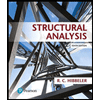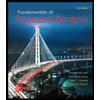
UCD FUND OF STRUCTURAL ANALYSIS 5E
5th Edition
ISBN: 9781264843923
Author: Leet
Publisher: MCG
expand_more
expand_more
format_list_bulleted
Concept explainers
Question
Chapter 12, Problem 50P
To determine
Draw the influence lines for vertical reaction at support A and the moment at support C.
Evaluate the ordinates at 6-ft intervals of the influence line.
Expert Solution & Answer
Want to see the full answer?
Check out a sample textbook solution
Students have asked these similar questions
Q1) Compute the ultimate bearing capacity using the Vesic
method
0.6 m
0.8 m
580 kN
200 kN
y=17.29 kN/m³
Ysat 19.3 kN/m³
T
2.0 m
200 kN
150 kN
3.0 m
GL
✓
WT
0.6 m
c=26 kN/m²
=26°
Please do not use any AI tools to solve this question.
I need a fully manual, step-by-step solution with clear explanations, as if it were done by a human tutor.
No AI-generated responses, please.
what is admixture and what are the characteristics of it explain in detail
Chapter 12 Solutions
UCD FUND OF STRUCTURAL ANALYSIS 5E
Ch. 12 - Prob. 1PCh. 12 - Prob. 2PCh. 12 - Prob. 3PCh. 12 - Prob. 4PCh. 12 - Prob. 5PCh. 12 - Prob. 6PCh. 12 - Prob. 7PCh. 12 - Prob. 8PCh. 12 - Prob. 9PCh. 12 - Prob. 10P
Ch. 12 - Prob. 11PCh. 12 - Prob. 12PCh. 12 - Prob. 13PCh. 12 - Prob. 14PCh. 12 - Prob. 15PCh. 12 - Prob. 16PCh. 12 - Prob. 17PCh. 12 - Prob. 18PCh. 12 - Prob. 19PCh. 12 - Prob. 20PCh. 12 - Prob. 21PCh. 12 - Prob. 22PCh. 12 - Prob. 25PCh. 12 - Prob. 26PCh. 12 - Prob. 27PCh. 12 - Prob. 28PCh. 12 - Prob. 29PCh. 12 - Prob. 30PCh. 12 - Prob. 31PCh. 12 - Prob. 32PCh. 12 - Prob. 34PCh. 12 - Prob. 35PCh. 12 - Prob. 36PCh. 12 - Prob. 37PCh. 12 - Prob. 38PCh. 12 - Prob. 39PCh. 12 - Prob. 40PCh. 12 - Prob. 41PCh. 12 - Prob. 42PCh. 12 - Prob. 43PCh. 12 - Prob. 44PCh. 12 - Prob. 45PCh. 12 - Prob. 46PCh. 12 - Prob. 49PCh. 12 - Prob. 50PCh. 12 - Prob. 51PCh. 12 - Prob. 52PCh. 12 - Prob. 53PCh. 12 - Prob. 54PCh. 12 - Prob. 57PCh. 12 - Prob. 58P
Knowledge Booster
Learn more about
Need a deep-dive on the concept behind this application? Look no further. Learn more about this topic, civil-engineering and related others by exploring similar questions and additional content below.Similar questions
- Robert Moses is one of the most influential—and controversial—figures in American urban planning history. His imprint on New York City and its surrounding regions remains evident in highways, parks, bridges, and housing policies. However, his approach to planning often excluded public input and disproportionately harmed communities of color and low-income populations. This assignment challenges you to reflect critically on Moses’ legacy and draw connections to contemporary urban planning challenges. Reflect on Power and Authority in Planning: How did Robert Moses’ accumulation and use of unelected power shape the urban landscape of New York? What lessons can modern planners learn about checks and balances in urban development? Community Impact Analysis: Identify and discuss at least one community or population that was negatively impacted by Moses' planning decisions. What were the long-term effects on that community? How might a more equitable planning process have changed the…arrow_forwardAfter watching the video "The Rise and Fall of Robert Moses" (Vox), write a 1-page (approximately 500 words) double-spaced response that addresses the following: Reflect on Power and Authority in Planning: How did Robert Moses’ accumulation and use of unelected power shape the urban landscape of New York? What lessons can modern planners learn about checks and balances in urban development? Community Impact Analysis: Identify and discuss at least one community or population that was negatively impacted by Moses' planning decisions. What were the long-term effects on that community? How might a more equitable planning process have changed the outcome? Contemporary Relevance: Can you identify a current or recent urban planning decision (local, national, or international) that echoes the same issues of power, displacement, or inequity? Compare the two and discuss how modern planners might address these concerns differently.arrow_forwardPlease answer the question in the picture and make sure your work is correct please. Thank youarrow_forward
- Solve the problem in the picture please only solve the part for the wall load at assuming rigid diaphragm please. Make sure you do the right work and show all of your work please. Thank you!arrow_forwardPlease solve this and make sure you show all of your work, Thank you for your help!arrow_forward15'-0" 15'-0" Architect specifications: 1) Superimposed dead load (including finishes, partition, mep etc) for each floor are shown next page. 2) The facade weight is 200 plf and it's all around the building, the parapet weight at the roofs is 100 plf. Don't forget to add these loads at the perimeter beams. 3) Wind Load is 30 psf 4) Use steel or LVL for beams, TJI of common wood for joists. 5) Submit your calc package by Sunday May 11th ALL STRUCTURAL ITEMS IN RED ARE PART OF THE GRAVITY SYSTEM ALL STRUCTURAL ITEMS IN BLUE ARE PART OF THE LATERAL SYSTEM I 10'-0" 2 10'-0" 10'-0" B I I I LAYOUR FOR OFFICES Things Required Dead and Live Load Schedule Gravity design for office floor - Load calculations (DL + LL + facade load if on perimeter) Beam sizing Joist spacing/type (TJI or LVL) Provide calculations for: Reaction forces Maximum moments Shear • Beam sizes (steel or LVL) Key Map of elements (your office layout plan with beam/joist marks) Iarrow_forward
- please solve the problem in the picture make sure you show all of your work, thank you so much for your help!arrow_forwardPlease solve the question in the picture make sure you show all of your work and show every step you do please. Thank you so much for your help!arrow_forwardPlease answer the question in the picture. solve for the ground level and also for the 2nd level please. Make sure to show all of your work. Thank you for your help!arrow_forward
- Q3: Assuming the length of all vehicles is 6 m and the road length is 300 m, determine: SMS, TMS, Density, average spacings between vehicles and average headway at A- A section. 50 kph Veh 4 70 m 40 kph Veh 3 60 m 30 kph Veh 2 20m 25 kph A Veh 1 Traffic direction A (40 marks)arrow_forwardThe drainage system shown in fig 14.35 is designed to collect the stormwater from 3 atreas The areas runoof coefficients and overland flow times are as follows The rainfall intensity i (mm/h) as a function of rainfall duration t(min) is i =1.12/t+110 The flow time in sewer 1-2 is 2min and in sewer 2-3 is 2.5 minarrow_forwardPlease answer the question from the picture, show each step and explain please. Thank you so mucharrow_forward
arrow_back_ios
SEE MORE QUESTIONS
arrow_forward_ios
Recommended textbooks for you

 Structural Analysis (10th Edition)Civil EngineeringISBN:9780134610672Author:Russell C. HibbelerPublisher:PEARSON
Structural Analysis (10th Edition)Civil EngineeringISBN:9780134610672Author:Russell C. HibbelerPublisher:PEARSON Principles of Foundation Engineering (MindTap Cou...Civil EngineeringISBN:9781337705028Author:Braja M. Das, Nagaratnam SivakuganPublisher:Cengage Learning
Principles of Foundation Engineering (MindTap Cou...Civil EngineeringISBN:9781337705028Author:Braja M. Das, Nagaratnam SivakuganPublisher:Cengage Learning Fundamentals of Structural AnalysisCivil EngineeringISBN:9780073398006Author:Kenneth M. Leet Emeritus, Chia-Ming Uang, Joel LanningPublisher:McGraw-Hill Education
Fundamentals of Structural AnalysisCivil EngineeringISBN:9780073398006Author:Kenneth M. Leet Emeritus, Chia-Ming Uang, Joel LanningPublisher:McGraw-Hill Education
 Traffic and Highway EngineeringCivil EngineeringISBN:9781305156241Author:Garber, Nicholas J.Publisher:Cengage Learning
Traffic and Highway EngineeringCivil EngineeringISBN:9781305156241Author:Garber, Nicholas J.Publisher:Cengage Learning


Structural Analysis (10th Edition)
Civil Engineering
ISBN:9780134610672
Author:Russell C. Hibbeler
Publisher:PEARSON

Principles of Foundation Engineering (MindTap Cou...
Civil Engineering
ISBN:9781337705028
Author:Braja M. Das, Nagaratnam Sivakugan
Publisher:Cengage Learning

Fundamentals of Structural Analysis
Civil Engineering
ISBN:9780073398006
Author:Kenneth M. Leet Emeritus, Chia-Ming Uang, Joel Lanning
Publisher:McGraw-Hill Education


Traffic and Highway Engineering
Civil Engineering
ISBN:9781305156241
Author:Garber, Nicholas J.
Publisher:Cengage Learning